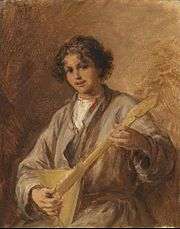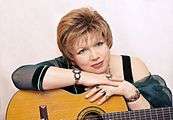Russian romance
| Music of Russia | |
|---|---|
 | |
| Genres | |
| Specific forms | |
| Religious music | |
| Traditional music | |
| Media and performance | |
| Music awards | |
| Music charts | |
| Music festivals |
|
| Music media | |
| Nationalistic and patriotic songs | |
| National anthem | Anthem of Russia |
| Regional music | |
| Local forms | |
| Related areas | |
Russian romance or Russian Gypsy song (Russian: романс) is a type of sentimental art song with hints of Gypsy influence that was developed in Imperial Russia by such composers as Alexander Alyabyev (1787–1851), Alexander Varlamov (1801–48), and Alexander Gurilyov (1803–58).[1]
By the early 20th century, several types of the Russian romance had emerged. An elite type of the Italianate opera-influenced song known as the "salon romance" is contrasted to the lower-class genre of "cruel romance" which features "senitimental courtship, illicit love, pained rejection, and often suicide".[2] The latter is supposed to have given birth to the Russian chanson.
The Russian romance had its heyday in the 1910s and 1920s when the top performers included Anastasia Vyaltseva, Varvara Panina, Nadezhda Plevitskaya, Tamara Tsereteli, Pyotr Leshchenko, and Alexander Vertinsky. In the early Soviet era the genre was less favoured, as it was seen as a vestige of the pre-revolutionary "decadent and bourgeois" sensibility through much of the 20th century.[3]
A new generation of singers, such as Valentina Ponomaryova and Nani Bregvadze, emerged in the 1970s. Several vocalists from the pre-World War II era, including Izabella Yurieva (1902–2000), Vadim Kozin (1903–1994) and Alla Bayanova (1914–2011), also returned to prominence in the late Soviet years. Alexander Malinin, Sergey Zakharov and Oleg Pogudin are among the Russian romance singers active in the 21st century.
César Cui's 1895 book Russian Art Song: A Study of Its Development was translated in J.R. Walker’s Classical Essays on the Development of Russian Art Songs (Northfield, MN, 1993).
Notable songs
- Black Eyes
- Shine, Shine, My Star
- Along the Long Road
- Evening Bell
- Les Chrysanthemes
Gallery
- 21st century Russian romance singers




References
- ↑ Art and Culture in Nineteenth-Century Russia (ed. Theofanis George Stavrou). Indiana University Press, 1983. ISBN 9780253310514. Page 75.
- ↑ Entertaining Tsarist Russia: Tales, Songs, Plays, Movies, Jokes, Ads, and Images from Russian Urban Life, 1779–1917. Indiana University Press, 1998. ISBN 9780253211958. Page xxii.
- ↑ David MacFadyen. Songs for Fat People: Affect, Emotion, and Celebrity in the Russian Popular Song, 1900–1955. McGill-Queens University Press, 2002. ISBN 9780773524415. Page 13.
External links
- Russian composers and singer-songwriters of 19th century (English), an educational site
- Synthesis of poetry and music (Russian), a site dedicated to Russian romance